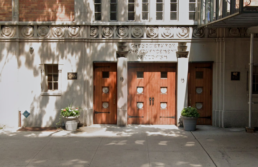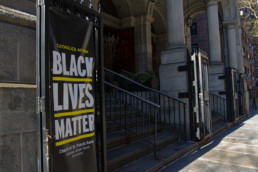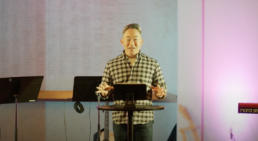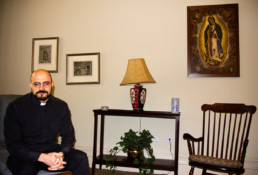A Renewed Connection on the Upper West Side
Every Sunday since the pandemic began Hope West Side hosts two services. The evangelical Christian congregation rents the sanctuary of the Society for the Advancement of Judaism on West 86th Street and Central Park West. Inside you won’t see a cross, but you will see Jewish symbols in the colorful stained-glass windows. Under every seat are Shabbat prayer books instead of Christian Bibles. Hope West Side is a newer congregation, only founded in 2018. Because the Society for the Advancement of Judaism holds its services on Saturdays, it allows Hope West Side to have the space on Sundays. When the pandemic hit, though, the building went dark and both the Jewish and the Christian congregations were homeless.
The services went online, starting out with pre-recorded live streams and moving on to Zoom meetings, but some of those involved with the church felt this deprived them of a sense of community within the church. Christina Jackson serves as the communications director and tries to engage members during the year of virtual worship.
“I think it’s hard because part of the reason why I come to church at least is for the community,” Jackson said. “We tried our best to have the chat box going on the YouTube Live Stream and reach out to people we were already connected with, but for new people, it was really hard.”
Finally, last June, after 14 months, the church was able to hold services in person, while also streaming to the web, but not without challenges. The church had to purchase and set up cameras, WIFI and projectors. In the back of the worship space a large camera manned by volunteers captures the worship music, the sermon and then the worship music again, but of course it misses the connection between worshipers before and after the services. Those who did attend in person, didn’t fully get that connection either.
The Society for the Advancement of Judaism lowered the number of people permitted in the building at any given time, to ensure proper social distancing requirements were met. Hope West Side switched from holding one service, as they did before the pandemic, to two services. This way, half of the churchgoers would attend each one, with around 30 at each. This worked for a while, but once the Society for the Advancement of Judaism lifted that restriction, Pastor Mike Park enthusiastically announced that the congregation would return to one service. This announcement was met with cheers from the churchgoers.
“I realize there’s a couple things that we’ve lost in having two services,” Park said. “We are never in the same room together.”
On February 27th, Hope West Side held their first in-person singular service since the beginning of March 2020. Nearly every seat was filled, with around 70 people in attendance, all wearing the name tags given to them at the door when they completed their Covid-19 screenings. Before and after the service people laughed and talked. They poured and sipped on coffee provided in the lobby. This 11 AM service represented a return to normalcy after nearly two years navigating Covid-safe services.
Along with this return, came the announcement of the first church retreat in two years. Taylor Fagins is the community life coordinator at the church and was excited to inform everyone of the trip upstate.
“It’s gonna be amazing, and I say that because I planned it,” he said to the congregation with an enthusiastic smile. This was met with laughter. “There’s gonna be hiking, board games, there might be some karaoke.”
Still, the church does take precautions to keep everyone safe, such as required masking and then health screenings at the door. They look forward to a time when they won’t have to do these things anymore.
“Maybe somewhere down the line we can unmask,” said Christina Jackson. “I think we are just playing it by ear and just doing what the whole city is doing: trying to keep everyone safe.”
Social Justice Meets the Mass
Counting hymnal mentions, the word ‘mercy’ was intoned 37 times during the 9 a.m. service on a recent Sunday at St. Francis Xavier, a Roman Catholic church in the Jesuit tradition, snugly situated in the Flatiron District neighborhood of Manhattan.
The Rev. Kenneth Boller made the concept of mercy progressively applicable throughout the service. After an hour of traditional Catholic liturgy, he led the congregation in a more contemporary affirmation.
“Do you affirm that white privilege is unfair and harmful to those who have it and to those who do not? Do you affirm that white privilege and the culture of white supremacy must be dismantled where it is present? Do you support racial equity justice and liberation for every person? Do you affirm the inherent worth and dignity of every person?"
The congregation of 100 people answered “yes” to each of these questions with enthusiasm. In so doing, the members of St. Francis Xavier have been committing themselves to these social justice principles every week since the affirmation was first introduced on Aug. 30, 2020.
Since then, some conservative commentators have attacked gone on the attack. A few agitated Twitter users have accused Boller of turning his service into “a left-wing political rally.” Videos of the service have gone viral. The conservative entertainment company Blaze Media, which reaches 165 million people every month, published an article calling the statements “revolting.” Trudging past online criticism, Boller’s affirmations prevailed.
Doing no harm is a form of activism, Boller said. Led by the Holy Spirit, Catholics ought to be able to avoid harming all people via radical mercy.
The Church of St. Francis Xavier is unafraid to live in the tension between tradition and progress. Comfortable with anachronism, this house of worship is a place where Boller, the church’s pastor standing at a pulpit built in 1850, will readily grapple with issues like cyberbullying and misinformation on social media. This conflict echoes the tensions within American Catholicism today. The religious are taking sides between loyalty to a centuries-old establishment and dissent. But this Jesuit congregation rejects the binary altogether - in the name of mercy.
In his Sunday sermon, Boller took on everyone from the Biblical David to the contemporary leaders of the Roman Catholic Church.
The scriptural reference in the homily, or the commentary lesson that follows worship, was 1 Samuel 26. In this part of the Bible, David spared his sleeping enemy, Saul, who was the first king of Israel with a militaristic streak. David, who will (spoiler alert) eventually replace Saul as Israel’s leader, justified his merciful choice to not stab his adversary when he said, “Do not destroy Saul, for who can put out his hand against the Lord's anointed people and be guiltless.” David believed God valued some lives more than others; God prioritized the blessed nation of Israel above those of any other descent or station Boller explained.
Boller went on to commend David’s choice to do no harm but criticized David’s reasoning for doing so. Peaceful action without equitable intention is not good enough, the Queens-native pastor argued. The key to not harming others is knowing God loves all people equally, he added, this democratization of access to salvation hinges on living out the Gospel. Do not be like David, Boller said to his audience.
Deliberately not causing harm is a high Catholic standard that extends politically, interpersonally, virtually, physically, racially, emotionally and sexually. At that last point, Boller waved his hands around to referentially gesture the credible claims of abuse plaguing Catholic leadership. Thereafter, Boller brought up the famous creed of bioethics and a variation of the Hippocratic Oath, “First, do no harm,” which Boller said should be applied by the scientific and religious alike. Catholics are not appointed to punish the people who wrong them. Quite the opposite is true, Boller concluded. Much like the medical field, Boller said, the Catholic tradition possesses a life-giving tool of mercy, which should lead worshippers to accomplish good in the world. The Catholic ideals entail turning the other cheek, (Matthew 5:39).
“Differences of power and resources just give some people more responsibility of helping the common good,” Boller said.
A Prayer By Our Father, For His People
A man with a handheld microphone stands at the front of the room. Behind him, the wall is cast with lilac lights. He’s Taylor Figgins, the community life coordinator at Hope West Side, a church located on 86th Street and Central Park West.
“Let’s stand and pray the Lord's Prayer together,” he says in a soft voice.
The room of about 25 people shifts and every single person stands to recite the prayer. The creaking of chairs and brushing of coats and bags echo in the room as they do this. Some lift their bibles or their notebooks from their laps with them. Once standing they turn and lean down to place the books on the seats behind them. They bow their heads and close their eyes. Many clasp their hands together, while others open their arms out in front of themselves to “open themselves up to Jesus.” There are two screens at the front of the congregation, one on each side of the room. The words to The Lord’s Prayer appear on each one. The crowd recites it quietly in unison, some from memory and some reading off the screens.
Hope West Side is a progressive Evangelical Church established in 2018. The churchgoers recite the Lord’s Prayer at the same moment at every service: right before the sermon.
“We pray the Lord’s Prayer as a way to connect our Hope West Side church community to the generations of believers who have prayed this prayer since the beginning of the early church,” said Park.
“Our Father in heaven,
hallowed be your name,
your kingdom come,
your will be done,
on earth as it is in heaven.
Give us today our daily bread.
And forgive us our debts,
as we also have forgiven our debtors.
And lead us not into temptation,
but deliver us from the evil one.”
“For Yours is the kingdom and the power and the glory forever. Amen.”
Figgins says each phrase gently, taking time to pause in between each one. As they recite the prayer, one word is louder than all the rest. Everyone says Amen with certainty. This closes out the prayer and they all sit down to listen to the pastor’s prepared sermon.
This prayer is from the New Testament in Matthew 6:9-13. In this passage, Jesus explains to the disciples how they should pray, and recites this prayer as an example. The last line comes from newer versions of the bible and church tradition, whereas the rest is from the ancient text.
“It gives us a template for how Jesus wants us to pray,” says Pastor Mike Park, who sits in the front row. He says the prayer with his head bowed. “We could also say it’s the prayer that is formulated by God for us, while most of our prayers are formulated by us for God.”
He views this prayer as a point of connection between all Christian denominations.
“It’s also one of the oldest recorded Christian prayers and is common to the different streams of Christian faith: Protestant, Orthodox, Catholic,” Park says. “So it’s one of the prayers that we can usually pray together regardless of church background or tradition.”
For some believers, the prayer serves as a point of connection between themselves and God, one that they feel can and should be made often.
“There are many seasons where I will pray the Lord’s Prayer slowly several times a day, pausing at each line to think through the truth of that part of the prayer,” says Park.
The Blessed and Pink Dressed
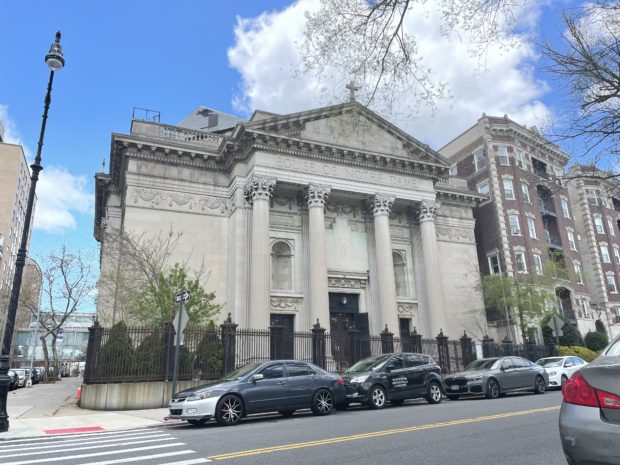
I had visited Catholic churches before. Whether in Italy, Spain or New York, they always struck me with the same haunting silence.
Aside from the faint echo of monastic chants or organ chords, it was quiet. If I listened too hard, it was like I could hear someone whispering through the stone walls. Maybe believers heard Jesus in the whispers, and that’s why they sat so earnestly in the brown pews.
I couldn’t hear Jesus the way that they did so their prayers fell upon my arms and legs like chills. I entered the Church of Notre Dame in New York with only the expectation of echoes.
The church on 114th Street and Morningside Drive was hidden in plain sight, with a fence on the corner blocking it off from the noise of the neighborhood. A path through a small garden led either to the chapel where the priests said mass or to the rectory, where they lived.
As I entered the chapel, I saw one woman alone, her gaze fixated on the marble altar at the front of the room. . Her bright pink dress stood out from the clean, holy, untouched marble. With a mask on, she looked as if she could be an older cousin of mine, her black frizzy-wavy hair down her back, tan skin warm against the floral pink.
She arrived at the Tuesday service at least an hour earlier than everyone else. As she waited, she sat in a pew near the raised statue of the Virgin Mary. She looked between Mary and Jesus in reverence, muttering under her breath with her hands folded on her lap. It was like she knew God was coming.
Catholics believe that, in 1858 in Lourdes, France, the Virgin Mary appeared to a woman who would later be recognized as St. Bernadette. The New York church replicated this moment in a grotto in stone at the front of the chapel. The gray stone looked real, like someone had carved into the building itself to reveal its earthy interior. The grotto looked so natural against the stark white marble that it lured me into the scene of the Virgin’s apparition.
As she sat, the woman in pink held the same facial expression as the memorialized St. Bernadette–a combination of awe and longing.
While the priest gave his homily, the woman in pink was seated one row across from me, with her eyes laser focused on the book he was reading from. The Good Book, the word of God Himself, the Holy Bible.
She seemed to know every word to every prayer the priest spoke. I followed her to know when to stand up and sit down, and when to bow my head. But when she rose to take the Eucharist–the wine and bread that Catholics believe to be the real body and blood of Christ – I stayed in my seat. There are some moments that are only meant for true believers.
The woman in pink gracefully consumed Jesus’s body and knelt on the pew closest to Him to pray. As I sat in my pew, I tried to talk to God. But it felt like I needed someone to translate for me, like I couldn’t reach Him in the same way that everyone else could.
Her prayer was long. I could see in the folds of her face that she was fervently praying to God, faithfully asking for help and expressing her pious devotion. I wanted so badly for all of her prayers to be answered. But neither I, nor she, knew if they ever would be.
When she sat back down at the end of service, she started singing on cue with the other worshippers; out of tune, at a higher volume than the rest, but with the passion of someone who knew the song well and believed every word. It was a hymn about Jesus, but I couldn’t pick out the melody from her shouted notes.
She closed her eyes and remained in her seat. As I left the church, she was still singing.
For Catholics, Sometimes the Body Is a Prayer
Countless embellishments compete for the visitor’s attention as she steps into the Church of St. Francis Xavier, a Jesuit house of worship in the Flatiron District of Manhattan. The décor is so distracting that she may miss her cue to stand in prayer or kneel in submission.
The early morning sunlight turns blue as it shines through stained glass windows, which have the color-scheme of a peacock. For every detailed oil painting of a saint, there is a corresponding warm glow emitting from lanterns or candles. The building is drenched in ornate, pious eye candy. However, the culmination of the basilica is the sizable, golden Gospel Book, resting on a slanted stand at the front of the church.
Behind the stand is the Rev. Ricardo da Silva, St. Xavier’s associate pastor, who recited the Lord’s Prayer with his arms stretched out and his palms facing the rotundas. This position is the “orans position,” which comes from the Latin word meaning pray. This position during Mass is symbolic of leadership in prayer. It is called for the priest alone during the Our Father prayer, with the elbows close to the sides of the body and with the hands outstretched sideways, palms up. The orans position exemplifies Catholic deference of the church hierarchy and the Church’s belief that the body is a necessary mechanism of communication for the spirit.
As the priest, da Silva is a representative of God, who utilized this body position to invite the Holy Spirit into the Church. The priest’s fingers, facing the heavens, are a privileged symbol of a leader’s power in prayer and praise.
Biblically, this position is a sign of surrender. An example of the orans position is in Exodus 17:11, which stated, “as long as Moses held up his hands, the Israelites were winning, but whenever he lowered his hands, the Amalekites were winning." Completely submitting to God by lifting the hands benefitted Moses, allowing the Hebrew prophet to protect and led his people.
During the prayer, a nearby mother swatted her seven-year-old’s little hands down, which were previously outstretched with palms up, mimicking Father Ricardo. The mother’s scold can be translated to mean that the orans position of prayer is reserved for the office of the priest. Justification for making this position exclusive lies in the Church’s liturgical documents, Instruction On Certain Questions Regarding the Collaboration of the Non-Ordained Faithful in the Sacred Ministry of Priests.
"In eucharistic celebrations, neither may deacons or non-ordained members of the faithful use gestures or actions which are proper to the same priest celebrant,” stated the Vatican in 1997. “It is a grave abuse for any member of the non-ordained faithful to ‘quasi preside’ at the Mass while leaving only that minimal participation to the priest which is necessary to secure validity.”
The child’s confusion was understandable. Not following the priest’s moves is an exception to customs. A general rule of thumb for an unconfirmed or unfamiliar person at a mass service is to imitate the posture of those around her. When others stand to pray, she rises to her feet. Standing in Catholicism is considered the appropriate position for prayer and is also a way to show awe to Jesus, who is represented by the priest during Mass. When the celebrant instructs the laity to sit, she takes the weight off her feet. When the laity kneels, she shifts to her knees. When worshippers genuflect, they submit to their Heavenly Father. The priest is a representative of Jesus, he leads the congregation to do gestures and rituals that are part of the Catholic Mass Order.
With all of that moving around, the role of the corporal body in the church’s body was paramount. But changing postures was not simply posturing. The physical positions symbolized believers’ spiritual pleadings - all in unison. The worshippers did so (or, in the case of the orans position, did not do so), to respect the church hierarchy, and in turn, God.
Even in the progressive doctrines of St. Francis Xavier, which is an inclusive church that regularly advocates for racial justice and LGBTQIA rights, da Silva still found use for principles of posture and ritual.
“A new perspective can reveal the sanctity of tradition,” he said.

